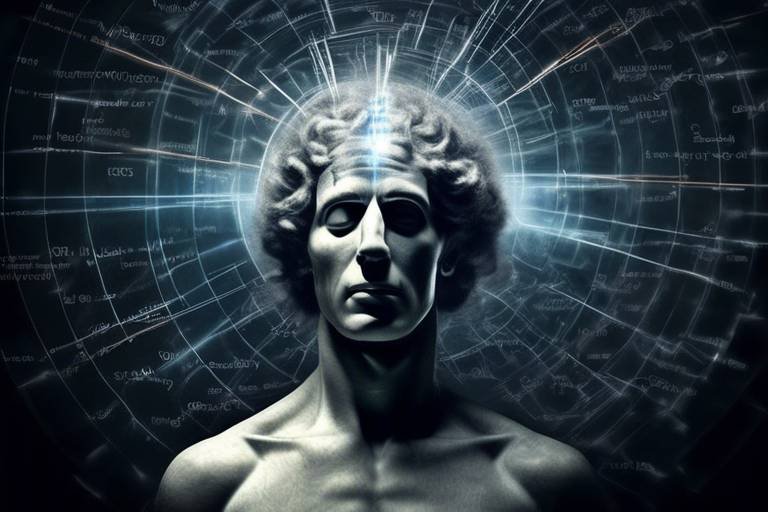Philosopher's Stone to Nuclear Physics - The Evolution
The journey from the mythical Philosopher's Stone to the groundbreaking field of nuclear physics is nothing short of extraordinary. It's a tale woven with threads of mysticism, scientific curiosity, and relentless pursuit of knowledge. Imagine a time when alchemists believed they could transform base metals into gold or discover the secret to eternal life. Fast forward to today, and we find ourselves unraveling the mysteries of the atom, a quest that has reshaped our understanding of the universe.
In this exploration, we will traverse the historical landscape that connects these two seemingly disparate realms. From the ancient practices of alchemy, which laid the groundwork for modern chemistry, to the revolutionary discoveries in nuclear physics that have altered the fabric of our society, each step is a testament to human ingenuity. It’s fascinating how the quest for transformation, once steeped in magic and mysticism, has evolved into a rigorous scientific discipline that powers our world today.
As we delve deeper, we will uncover the pivotal moments and key figures that have influenced this evolution. Think of alchemy as a bridge, one that connects the esoteric with the empirical, guiding us toward a more profound understanding of matter and energy. Each alchemical experiment, each philosophical treatise, contributed to the rich tapestry of science, culminating in the birth of chemistry and, eventually, nuclear physics.
But what does this journey mean for us in the modern age? The implications are vast. The discoveries in nuclear physics not only fuel our power plants but also raise ethical questions about their use in warfare. As we navigate this complex landscape, we must consider the legacy of those who sought knowledge—both the alchemists of old and the physicists of today. Their stories remind us that the quest for understanding is as much about responsibility as it is about discovery.
So, buckle up as we embark on this fascinating journey through time, exploring the alchemical roots that have blossomed into the vibrant field of nuclear physics. It’s a story of transformation, not just of materials, but of human thought itself.
- What is the Philosopher's Stone? The Philosopher's Stone is a legendary substance in alchemy believed to have the ability to turn base metals into gold and grant immortality.
- How did alchemy contribute to modern science? Alchemy laid the groundwork for modern chemistry by introducing experimental techniques and the systematic study of materials.
- What are some key discoveries in nuclear physics? Key discoveries include the neutron, nuclear fission, and advancements in understanding atomic structure.
- What ethical concerns arise from nuclear physics? Ethical concerns include the potential for nuclear weapons and the implications of nuclear energy on society and the environment.

The Myth of the Philosopher's Stone
The Philosopher's Stone has captivated the minds of many throughout history, embodying the quest for transformation and the elusive promise of immortality. Rooted deeply in the tradition of alchemy, this mythical substance was believed to possess the power to turn base metals into gold and grant eternal life. Imagine a world where a mere stone could unlock the secrets of the universe, a world where the mundane could become extraordinary. This quest for the Philosopher's Stone is not just a tale of alchemy; it is a reflection of humanity's enduring desire for knowledge and transcendence.
The origins of the Philosopher's Stone can be traced back to ancient civilizations, where it was often linked to the spiritual and mystical. Alchemists viewed it as a metaphorical representation of the transformation of the self, a journey towards enlightenment and perfection. The Stone was not merely a physical object; it symbolized the alchemist's inner quest for wisdom and understanding. Throughout history, various cultures have contributed to this mythos, each adding layers of meaning and significance.
In the Middle Ages, the Philosopher's Stone became a central focus for many alchemists, who believed that its discovery would lead to the ultimate goal of alchemy. This period was marked by intense experimentation and the development of intricate theories. Alchemists like Nicolas Flamel and Albertus Magnus sought the Stone, leaving behind a legacy of texts filled with cryptic symbols and allegories. Their works not only fueled the imaginations of future generations but also laid the groundwork for the scientific inquiries that would follow.
But what exactly was the Philosopher's Stone believed to do? Here are some of its attributed powers:
- Transmutation: The ability to convert base metals into gold.
- Elixir of Life: A potion that grants immortality and cures ailments.
- Universal Solvent: A substance that could dissolve any material.
As the centuries progressed, the allure of the Philosopher's Stone began to wane, particularly with the rise of the scientific method. The transition from mystical beliefs to empirical observation marked a significant turning point in human understanding. Alchemy, once shrouded in mystery, started to give way to the principles of modern chemistry. However, the legacy of the Philosopher's Stone remains a powerful symbol in the collective consciousness, representing the eternal human quest for knowledge and the transformative power of discovery.
In conclusion, the myth of the Philosopher's Stone is not just an ancient tale; it is a reflection of our innate desire to explore, understand, and transcend the limitations of our existence. As we delve into the realms of science, the echoes of alchemical thought remind us of the profound journey from the mystical to the empirical, illustrating how far we have come in our quest for knowledge.
- What is the Philosopher's Stone? The Philosopher's Stone is a legendary alchemical substance believed to turn base metals into gold and grant immortality.
- Who were some famous alchemists? Notable alchemists include Nicolas Flamel, Hermes Trismegistus, and Paracelsus, each contributing significantly to the field of alchemy.
- How did alchemy influence modern science? Alchemy laid the groundwork for modern chemistry and physics, introducing experimental methods and the pursuit of knowledge.

Alchemy: The Bridge to Modern Science
Alchemy, often regarded as the precursor to modern science, served as a fascinating bridge between mystical traditions and empirical inquiry. Imagine a world where the line between magic and science was blurred, where the quest for the Philosopher's Stone symbolized not just the pursuit of gold, but also the transformation of the self and the universe. Alchemists were not merely proto-chemists; they were philosophers, mystics, and early scientists who sought to understand the natural world through a combination of observation, experimentation, and spiritual insight.
During the Middle Ages, alchemy flourished in various cultures, including the Islamic Golden Age, where scholars like Jabir ibn Hayyan (Geber) laid foundational principles that would later influence modern chemistry. Alchemists believed that all matter was composed of four elements: earth, water, air, and fire. This elemental theory, while simplistic by today's standards, encouraged a systematic approach to understanding substances and their transformations. It was through these early experiments that alchemists began to discover the properties of various materials, setting the stage for the scientific method.
As alchemy evolved, it incorporated rigorous methodologies that emphasized observation and reproducibility. For instance, the practice of distillation, which originated in alchemical laboratories, allowed for the separation and purification of substances. This process not only advanced the understanding of chemical reactions but also paved the way for the development of modern laboratory techniques. The alchemical motto "As above, so below" reflects the belief that the microcosm of the human body mirrored the macrocosm of the universe, a concept that would resonate in scientific exploration for centuries.
Key figures in alchemy, such as Paracelsus, challenged traditional medical practices by emphasizing the importance of chemical substances in healing. Paracelsus famously stated, "The dose makes the poison," highlighting the significance of dosage in medicinal applications. This insight laid the groundwork for pharmacology, demonstrating how alchemical principles directly influenced the development of medical science.
While alchemy is often dismissed as mere superstition today, its legacy is undeniable. The transition from mystical alchemical practices to the empirical methods of modern science was gradual, marked by key developments such as the formulation of the scientific method by Francis Bacon and the establishment of chemistry as a distinct discipline by Antoine Lavoisier. These transformations were not just a rejection of alchemical thought; they were a refinement of its principles, leading to the rigorous science we know today.
In summary, alchemy acted as a crucial bridge to modern science by fostering a spirit of inquiry and experimentation. Although it may seem distant from the precision of contemporary science, the alchemical quest for knowledge laid the groundwork for future scientific breakthroughs. The journey from the mystical to the empirical is a testament to humanity's enduring curiosity and desire to understand the world around us.
- What is alchemy? Alchemy is an ancient practice that combines elements of philosophy, mysticism, and early science, focusing on the transformation of substances and the quest for knowledge.
- How did alchemy influence modern science? Alchemy contributed to the development of experimental methods, the understanding of chemical substances, and the foundations of modern chemistry and medicine.
- Who were some key figures in alchemy? Notable alchemists include Hermes Trismegistus, Paracelsus, and Jabir ibn Hayyan, each of whom made significant contributions to the field.
- Is alchemy still relevant today? While alchemy as a practice has largely been replaced by modern science, its principles and historical significance continue to inform our understanding of the development of scientific thought.

Key Figures in Alchemy
The world of alchemy is rich with fascinating characters who shaped the course of its history. Among these luminaries, Hermes Trismegistus stands out as a legendary figure, often regarded as the father of alchemy. His writings, attributed to the Hermetic Corpus, blend philosophy, spirituality, and science, laying the groundwork for alchemical thought. Hermes is often depicted as a bridge between the divine and the earthly, representing the quest for knowledge and transformation. His teachings emphasized the unity of all things, a concept that resonates deeply in both alchemical and modern scientific pursuits.
Another pivotal figure is Paracelsus, a Swiss physician and alchemist who revolutionized the understanding of medicine in the 16th century. He famously stated, "The dose makes the poison," highlighting the importance of chemistry in healing practices. Paracelsus believed that the human body was a microcosm of the universe, and by understanding the elements, one could unlock the secrets to health and disease. His approach to medicine was holistic, integrating the physical, spiritual, and environmental aspects of healing.
| Alchemist | Contribution | Era |
|---|---|---|
| Hermes Trismegistus | Foundation of Hermetic philosophy and alchemical principles | Ancient Egypt |
| Paracelsus | Integration of chemistry into medicine; holistic healing | 16th Century |
| Geber (Jabir ibn Hayyan) | Systematization of alchemical processes; introduction of experimental methods | 8th Century |
Another influential alchemist was Geber, known in the Western world as Jabir ibn Hayyan. He is often credited with the development of the scientific method in alchemy, emphasizing the importance of experimentation and observation. Geber's texts, filled with detailed descriptions of laboratory techniques and equipment, laid the foundation for future generations of chemists. His work not only advanced alchemical practices but also inspired the transition to modern chemistry.
Each of these figures contributed uniquely to the tapestry of alchemical knowledge, blending science with mysticism and philosophy. Their legacies continue to influence not only the fields of chemistry and medicine but also our understanding of the universe itself. The quest for the Philosopher's Stone, a metaphor for ultimate knowledge and transformation, encapsulates the spirit of these early alchemists, whose dreams and discoveries paved the way for the scientific revolution.
- What was the Philosopher's Stone? The Philosopher's Stone was a legendary substance in alchemy believed to have the ability to transform base metals into gold and grant immortality.
- Who was Hermes Trismegistus? Hermes Trismegistus is a mythical figure often associated with wisdom and the origins of alchemical thought, credited with writing the Hermetic Corpus.
- How did alchemy influence modern science? Alchemy introduced experimental methods and a systematic approach to studying materials, which laid the groundwork for modern chemistry and physics.
- What role did Paracelsus play in medicine? Paracelsus emphasized the importance of chemistry in medicine and introduced holistic approaches to healing, influencing modern medical practices.

The Role of Mysticism
The intertwining of mysticism and alchemy has always been a fascinating aspect of the historical journey towards scientific understanding. Alchemists were not merely scientists; they were also spiritual seekers, attempting to unlock the secrets of the universe through both physical experimentation and mystical insight. This dual approach allowed them to explore the mysteries of life and existence in ways that were often deeply personal and profoundly philosophical.
Mysticism, at its core, is about seeking a connection with the divine or understanding the ultimate nature of reality. For alchemists, this meant that their work was not just about transforming base metals into gold or discovering the Philosopher's Stone, but also about achieving a higher state of consciousness and spiritual enlightenment. They believed that by purifying substances, they could also purify their souls, leading to a form of immortality that transcended the physical realm.
Many alchemical texts are rich with symbolism and allegory, reflecting the mystical beliefs of their authors. For instance, the process of transmutation—turning lead into gold—was often viewed as a metaphor for personal transformation. Just as metals could be refined and perfected, so too could the human spirit. This idea parallels the journey of a caterpillar transforming into a butterfly, signifying growth and evolution.
Furthermore, alchemists often employed rituals and meditative practices to enhance their work. These rituals were meant to align their intentions with the universal energies they believed governed the material world. It was not uncommon for alchemists to invoke spiritual entities or symbols during their experiments, hoping to gain insight or assistance in their endeavors. The use of sacred geometry, astrological signs, and elemental correspondences was common, as they believed these tools could unlock hidden truths about nature.
Despite its mystical roots, alchemy laid the groundwork for modern scientific inquiry. The emphasis on observation and experimentation, even when intertwined with mysticism, encouraged a more systematic approach to understanding the natural world. This blend of the mystical and the empirical can be seen as a precursor to the scientific method, where hypothesis and experimentation are key components of discovery.
In conclusion, the role of mysticism in alchemy is a testament to the human quest for knowledge and understanding. It illustrates how deeply intertwined our spiritual beliefs can be with our scientific pursuits. As we continue to explore the universe, the lessons learned from these early alchemists remind us that the journey of discovery is as much about the questions we ask as it is about the answers we find.
- What is the Philosopher's Stone? The Philosopher's Stone is a legendary substance in alchemy believed to have the ability to turn base metals into gold and grant immortality.
- How did mysticism influence alchemy? Mysticism provided a spiritual dimension to alchemical practices, allowing alchemists to seek personal transformation alongside their scientific experiments.
- Can alchemy be considered a precursor to modern chemistry? Yes, many principles and practices of alchemy laid the foundation for the development of modern chemistry and the scientific method.
- What role did rituals play in alchemical practices? Rituals were used to align the alchemist's intentions with universal energies, often involving spiritual invocations and symbolic actions.

Alchemy's Influence on Medicine
Alchemy, often viewed through the lens of mysticism and magical transformation, played a surprisingly pivotal role in the early development of medicine. In the quest for the elusive Philosopher's Stone, alchemists conducted experiments that laid the groundwork for modern medicinal practices. They believed that everything in nature was interconnected, which led them to explore the therapeutic properties of various substances. This exploration was not merely a fanciful pursuit; it was a sincere attempt to understand the human body and its ailments.
One of the key contributions of alchemy to medicine was the concept of elixirs. Alchemists sought to create potions that could heal diseases or even grant immortality. Although the magical aspects of these elixirs have been debunked, the experimentation with different compounds led to the discovery of numerous medicinal properties. For instance, the alchemical practice of distillation, which involves heating a liquid to create vapor and then cooling it back into a liquid, was crucial in producing essential oils and tinctures that are still used in herbal medicine today.
Moreover, alchemists like Paracelsus revolutionized the way medicine was practiced by introducing the idea that the body could be treated with chemical substances. He famously stated, “The dose makes the poison,” emphasizing that the right amounts of substances could lead to healing rather than harm. This was a radical shift from the prevailing theories of the time, which often relied on humoral medicine—a belief that health was maintained by balancing bodily fluids. Paracelsus’s approach paved the way for the use of chemicals in medicine, marking a significant transition towards what we now recognize as pharmacology.
Additionally, alchemical texts often included detailed observations of symptoms and treatments, forming an early basis for clinical observation. Although many of the methods described were rudimentary and sometimes ineffective, the systematic approach to studying diseases and their cures was a precursor to modern clinical practices. The meticulous documentation of experiments and results laid the foundation for the scientific method, which would later dominate the field of medicine.
In summary, while alchemy is often dismissed as a mystical and outdated practice, its influence on medicine is undeniable. The alchemical pursuit of knowledge and transformation not only contributed to the development of early pharmacology but also encouraged a more systematic and experimental approach to understanding health and disease. The legacy of these early alchemists is still felt today, as many of their ideas and methods have evolved into the sophisticated medical practices we rely on.
- What is the Philosopher's Stone?
The Philosopher's Stone is a legendary substance in alchemy believed to have the ability to turn base metals into gold and grant immortality.
- How did alchemy influence modern science?
Alchemy laid the groundwork for modern chemistry and medicine by promoting experimental methods and the study of substances and their interactions.
- Who was Paracelsus?
Paracelsus was a Swiss physician and alchemist who is often referred to as the father of toxicology and modern pharmacology due to his emphasis on the use of chemicals in medicine.
- What are elixirs in alchemy?
Elixirs were substances sought by alchemists, believed to heal ailments and grant longevity, often created through processes like distillation.

Transition to Chemistry
The transition from alchemy to chemistry was nothing short of a revolution in scientific thought. Imagine standing at the edge of a vast ocean, where the mystical waters of alchemy meet the solid shores of chemistry. This shift didn’t happen overnight; it was a gradual process that unfolded over centuries, marked by critical discoveries and the gradual acceptance of empirical methods. Alchemy, with its roots deeply embedded in mysticism and philosophy, began to evolve as thinkers sought more practical and observable approaches to understanding the natural world.
As the Renaissance blossomed, a new wave of inquiry emerged, driven by a desire to unravel the mysteries of matter. Alchemists started focusing on the properties and transformations of substances rather than solely on the pursuit of the Philosopher's Stone. This shift was pivotal as it laid the groundwork for the scientific method, emphasizing observation, experimentation, and the reproducibility of results. Figures like Robert Boyle, often called the father of modern chemistry, championed this new approach, advocating for a clear distinction between chemistry and the mystical practices of alchemy.
One of the key developments during this transition was the formulation of the elements and the understanding of chemical reactions. Alchemists had long believed in a set of fundamental substances, but it was the chemists who began to classify and quantify these elements. The work of Antoine Lavoisier in the late 18th century was particularly transformative. He introduced the law of conservation of mass, which stated that matter cannot be created or destroyed in a chemical reaction. This principle was a cornerstone that helped establish chemistry as a rigorous science.
To illustrate the key differences between alchemy and chemistry, consider the following table:
| Aspect | Alchemy | Chemistry |
|---|---|---|
| Focus | Mystical transformation | Empirical study of matter |
| Methodology | Philosophical and speculative | Experimental and quantitative |
| Goals | Immortality, transmutation | Understanding and manipulation of substances |
| Legacy | Myth and mysticism | Foundation of modern science |
This table highlights how the transition involved a fundamental shift in both perspective and methodology. Alchemy’s legacy, while rich in history and cultural significance, ultimately paved the way for a more systematic and scientific approach to understanding the natural world. This evolution was not merely a change in terminology; it represented a profound transformation in human thought, leading to the birth of modern chemistry.
As we moved into the 19th century, chemistry began to flourish as a discipline. The establishment of chemical nomenclature, the periodic table by Dmitri Mendeleev, and advancements in organic chemistry were all milestones that signified the maturation of the field. The alchemical dream of transforming base metals into gold may have been abandoned, but the quest for knowledge and understanding of the universe continued to drive scientists forward, laying the groundwork for the remarkable discoveries that would follow in the realms of physics and beyond.
- What is the main difference between alchemy and chemistry?
Alchemy focuses on mystical transformations and philosophical concepts, while chemistry is based on empirical evidence and scientific methods. - Who is considered the father of modern chemistry?
Robert Boyle is often referred to as the father of modern chemistry for his contributions to the field and the scientific method. - How did the scientific method emerge from alchemical practices?
As alchemists began to emphasize observation and experimentation over mysticism, they laid the groundwork for the scientific method that is central to modern scientific inquiry.

The Birth of Nuclear Physics
The dawn of nuclear physics in the early 20th century marked a significant turning point in the realm of science, akin to discovering a hidden door in a long-forgotten castle. This new field of study, which focuses on the components and behavior of atomic nuclei, emerged from the ashes of earlier scientific endeavors and transformed our understanding of matter itself. Imagine a world where the very fabric of existence was being unraveled, revealing the intricate dance of particles that make up everything around us. This was the world of nuclear physics, bursting with potential and fraught with implications.
The journey began with the groundbreaking work of scientists like Ernest Rutherford, who, through his gold foil experiment in 1909, unveiled the nucleus of the atom. This was a revelation that shook the foundations of chemistry and physics, revealing that atoms were not indivisible as once thought, but rather composed of smaller particles. Rutherford's discovery laid the groundwork for future explorations into the atomic realm. The subsequent identification of the neutron by James Chadwick in 1932 further enriched our understanding, adding a new layer to the atomic structure and opening doors to a plethora of research opportunities.
As the 20th century progressed, the field of nuclear physics expanded rapidly, leading to the discovery of nuclear fission by Otto Hahn and Fritz Strassmann in 1938. This groundbreaking event was akin to finding the key to a treasure chest, revealing not only the potential for immense energy production but also the darker possibilities of nuclear weapons. The implications of fission were profound, igniting a race among nations to harness this newfound power, and ultimately leading to the development of the atomic bomb during World War II. The scientific community stood at a crossroads, grappling with the dual-edged sword of progress and ethical responsibility.
To better understand the evolution of nuclear physics, let’s take a look at some of the pivotal discoveries that shaped the field:
| Year | Discovery | Key Scientist(s) |
|---|---|---|
| 1909 | Discovery of the atomic nucleus | Ernest Rutherford |
| 1932 | Discovery of the neutron | James Chadwick |
| 1938 | Nuclear fission | Otto Hahn, Fritz Strassmann |
These discoveries not only revolutionized physics but also paved the way for numerous applications in various fields, from energy generation to medical technologies. The ability to manipulate atomic particles opened up a new frontier, allowing scientists to explore the nucleus in ways previously thought impossible. However, the rapid advancements in nuclear physics also raised significant ethical questions. How do we balance the pursuit of knowledge with the potential consequences of our discoveries? This question continues to resonate today, as the legacy of nuclear physics unfolds in our modern world.
In essence, the birth of nuclear physics was not just a scientific milestone; it was a cultural and ethical awakening. It forced humanity to confront the implications of harnessing the very building blocks of existence. As we look back at this transformative period, we must acknowledge both the triumphs and the tribulations that came with it. The exploration of nuclear physics continues to evolve, reminding us that with great power comes great responsibility.
- What is nuclear physics? Nuclear physics is the field of science that studies atomic nuclei, their components, and their interactions.
- Who were the key figures in the development of nuclear physics? Notable scientists include Ernest Rutherford, James Chadwick, and Otto Hahn.
- What are the applications of nuclear physics? Applications range from energy production in nuclear reactors to medical imaging and treatments.
- What ethical concerns are associated with nuclear physics? Ethical concerns include the potential for nuclear weapons proliferation and the safe disposal of nuclear waste.

Key Discoveries in Nuclear Physics
Nuclear physics, a field that has reshaped our understanding of the universe, owes its existence to a series of groundbreaking discoveries that emerged in the early 20th century. One of the most significant milestones was the discovery of the neutron by James Chadwick in 1932. Prior to this, scientists had a limited understanding of atomic structure, primarily focusing on protons and electrons. The neutron's existence not only provided a more complete picture of the atomic nucleus but also led to the realization that the nucleus is made up of protons and neutrons, collectively known as nucleons.
Following the discovery of the neutron, the concept of nuclear fission emerged, which was a game-changer in both physics and energy production. In 1938, German physicists Otto Hahn and Fritz Strassmann discovered that when uranium atoms were bombarded with neutrons, they split into smaller atoms, releasing a staggering amount of energy. This discovery was pivotal, as it laid the foundation for the development of nuclear reactors and atomic bombs. Imagine splitting an atom as if you were cracking a nut open; the energy released is akin to the explosive force contained within that tiny shell, waiting to be unleashed.
Moreover, the realization that nuclear fission could be harnessed for energy production sparked a revolution in how we approach power generation. The first nuclear reactor, known as Chicago Pile-1, was built in 1942 under the leadership of Enrico Fermi. This marked the dawn of the nuclear age, where scientists began to explore the potential of using nuclear reactions not just for destruction, but for peaceful purposes, such as generating electricity. The implications of this discovery were profound, leading to the establishment of nuclear power plants around the world.
As we delve deeper into nuclear physics, we must also acknowledge the role of quantum mechanics in shaping our understanding of atomic interactions. The principles of quantum mechanics allowed scientists to explore the behavior of subatomic particles, leading to the development of models that accurately describe the structure and behavior of atomic nuclei. For instance, the liquid drop model and the shell model emerged as essential frameworks for understanding nuclear stability and reactions.
To summarize the key discoveries in nuclear physics, let's take a look at the following table:
| Discovery | Year | Contributors | Significance |
|---|---|---|---|
| Neutron | 1932 | James Chadwick | Revolutionized atomic structure understanding |
| Nuclear Fission | 1938 | Otto Hahn, Fritz Strassmann | Foundation for nuclear reactors and bombs |
| First Nuclear Reactor | 1942 | Enrico Fermi | Initiated the nuclear energy era |
| Quantum Mechanics | Early 20th Century | Multiple contributors | Explained atomic interactions |
These discoveries not only advanced our scientific knowledge but also shaped the technological landscape of the 20th century and beyond. The combination of theoretical and experimental breakthroughs in nuclear physics has had lasting impacts, influencing everything from energy policies to international relations. As we continue to explore the mysteries of the atomic world, the legacy of these key discoveries remains a testament to human ingenuity and the relentless pursuit of knowledge.
- What is nuclear physics? - Nuclear physics is the branch of physics that studies atomic nuclei, their constituents, and their interactions.
- Who discovered the neutron? - The neutron was discovered by James Chadwick in 1932.
- What is nuclear fission? - Nuclear fission is the process of splitting an atomic nucleus into smaller parts, releasing a large amount of energy.
- How does nuclear energy work? - Nuclear energy is produced through nuclear reactions, primarily fission, which generates heat that can be used to produce electricity.

Ethical Implications of Nuclear Research
The advent of nuclear physics brought with it not only groundbreaking scientific advancements but also a myriad of ethical dilemmas that society continues to grapple with today. As we harness the power of the atom, we must pause and reflect on the profound responsibilities that accompany such knowledge. The dual nature of nuclear energy—its potential to both illuminate and annihilate—poses challenging questions that demand our attention.
One of the most pressing ethical concerns is the use of nuclear technology in warfare. The bombings of Hiroshima and Nagasaki during World War II serve as stark reminders of the devastating consequences of nuclear weapons. These events catalyzed a global discourse on the morality of nuclear armament, prompting questions such as: Should nations possess the capability to destroy entire cities? Is the deterrent effect of nuclear weapons worth the risk of catastrophic consequences? The specter of mutually assured destruction looms large, creating a paradox where peace is maintained through the threat of annihilation.
Moreover, the peaceful applications of nuclear energy, while beneficial, also raise significant ethical issues. The question of nuclear waste management is a critical concern. As we generate energy from nuclear fission, we are left with radioactive waste that can remain hazardous for thousands of years. How do we ensure the safety of future generations? The ethical obligation to protect the environment and public health is paramount, necessitating robust systems for waste disposal and management.
Additionally, the potential for nuclear technology to be misused by rogue states or terrorist organizations adds another layer of complexity. The proliferation of nuclear weapons poses a significant threat to global security. The ethical implications of sharing nuclear technology for peaceful purposes must be carefully weighed against the risks of it falling into the wrong hands. Is it right to advance scientific knowledge if it could potentially lead to greater harm?
To navigate these ethical waters, it is essential for scientists, policymakers, and the public to engage in open dialogue about the implications of nuclear research. Establishing international treaties and regulations can help mitigate risks, but a collective commitment to ethical standards is crucial. Education about the ethical dimensions of nuclear physics should be integrated into scientific curricula, fostering a generation of scientists who are not only knowledgeable but also socially responsible.
In conclusion, the ethical implications of nuclear research are complex and multifaceted. As we continue to explore the potential of nuclear physics, we must remain vigilant about the moral responsibilities that come with such power. Engaging in thoughtful discussions and making informed decisions will be vital in ensuring that the legacy of nuclear research is one of progress rather than destruction.
- What are the primary ethical concerns surrounding nuclear research? The main concerns include the use of nuclear weapons in warfare, the management of nuclear waste, and the potential for nuclear technology to be misused.
- How can society ensure the safe use of nuclear technology? By establishing international treaties, regulations, and promoting education on ethical standards in nuclear science.
- What role does public dialogue play in nuclear ethics? Open dialogue helps to raise awareness, foster understanding, and develop collective responsibility regarding nuclear research and its implications.
Frequently Asked Questions
- What is the Philosopher's Stone?
The Philosopher's Stone is a legendary substance in alchemy, believed to have the ability to turn base metals into gold and grant immortality. It symbolizes the ultimate goal of alchemical transformation and the quest for enlightenment.
- How did alchemy contribute to modern science?
Alchemy served as a precursor to modern chemistry and physics by introducing systematic experimentation and the pursuit of knowledge. Alchemists laid the groundwork for scientific methods, emphasizing observation and documentation, which became fundamental in scientific inquiry.
- Who were some key figures in the history of alchemy?
Notable alchemists include Hermes Trismegistus, often regarded as a mythical figure, and Paracelsus, who emphasized the importance of chemistry in medicine. Their philosophies and experiments significantly influenced the evolution of alchemical thought and practices.
- What role did mysticism play in alchemy?
Mysticism was deeply intertwined with alchemical practices, as many alchemists believed that spiritual transformation was essential to physical transformation. This blending of science and spirituality shaped their experiments and the interpretation of their results.
- How did alchemy influence early medicine?
Alchemy contributed significantly to early medicinal practices by introducing concepts of chemical compounds and the properties of substances. Alchemical theories helped in the development of herbal remedies and the understanding of human health, leading to advancements in medicine.
- What marked the transition from alchemy to chemistry?
The transition from alchemy to chemistry was marked by a shift towards empirical methods and the rejection of mystical explanations. Key discoveries, such as the identification of elements and the formulation of chemical laws, laid the foundation for chemistry as a formal scientific discipline.
- What is nuclear physics?
Nuclear physics is the field of physics that studies atomic nuclei and their interactions. It emerged in the early 20th century and has led to groundbreaking discoveries about atomic structure and the forces that govern nuclear reactions.
- What are some key discoveries in nuclear physics?
Key discoveries in nuclear physics include the identification of the neutron, the understanding of nuclear fission, and advancements in particle physics. These discoveries have had profound implications for energy production, medicine, and technology.
- What are the ethical implications of nuclear research?
The development of nuclear physics raises significant ethical questions, particularly regarding its applications in warfare and energy production. The moral considerations surrounding nuclear weapons and the potential for catastrophic consequences have sparked ongoing debates in society.



















